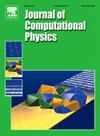稀疏流重建方法,以减少分析大型非稳定数据集的成本
IF 3.8
2区 物理与天体物理
Q2 COMPUTER SCIENCE, INTERDISCIPLINARY APPLICATIONS
引用次数: 0
摘要
写入、传输和存储大量非定常模拟数据的成本限制了整个解决方案的可访问性,通常会导致大部分流的采样不足或无法分析。例如,对罕见但重要的动态事件的瞬态行为进行建模需要在长时间内以高采样率编写三维快照。因此,所需的模拟时间和产生的大量数据使其成为实际计算流体动力学(CFD)工作流的一个具有挑战性的问题,其中内存资源通常有限,并且现代GPU计算的写入代价要高得多。在这项工作中,开发了多种稀疏流重建(SFR)方法,通过从CFD求解器中写入更少的稀疏测量值来近似完整的非定常解,从而降低了写入成本,数据存储,并实现了更高的采样率。SFR是由一个追求罕见进口畸变事件的大涡模拟(LES)示例驱动的,该示例表明,在全快照中进行降采样,辅以高频稀疏测量,可以大大减少GPU求解器的写入时间,并几乎消除CPU求解器的写入成本。在其最简单的形式中,“快照”SFR方法是一个方程,可以用适当正交分解(POD-SFR)或其更小更快的双POD-SFR变体进一步压缩。当本地内存不能存储整个解决方案时,流式SFR修改更有效地重建快照。一项敏感性研究评估了SFR尺度在稀疏采样率和重建精度之间的权衡,概述了最佳实践。为了抵消使用随机稀疏测量的误差,SFR方法通过额外指定稀疏测量位置来准确地保留指定流动区域的动力学,这里使用稀疏测量位置来捕获入口畸变事件。使用条件时空固有正交分解(CST-POD)对扭曲事件进行评估,以追求具有全分辨率上游因果关系特征的物理见解。CST-POD模式的验证研究证实了SFR在保留事件动态方面的有效性,同时节省了大量的计算和内存。本文章由计算机程序翻译,如有差异,请以英文原文为准。
Sparse flow reconstruction methods to reduce the costs of analyzing large unsteady datasets
The cost of writing, transferring, and storing large amounts of data from unsteady simulations limits the accessibility of the entire solution, often leaving the majority of the flow under-sampled or not analyzed. For example, modeling the transient behavior of rare, but important, dynamic events requires three-dimensional snapshots written at high sampling rates, over a long duration. As such, the simulation time needed and large quantity of data produced, makes this a challenging problem for practical computational fluid dynamic (CFD) workflows, where memory resources are often limited and the writing penalty for modern GPU computing is much costlier. In this work, multiple sparse flow reconstruction (SFR) methods are developed to approximate a full unsteady solution by writing far fewer sparse measurements from the CFD solver, thus diminishing writing costs, data storage, and enabling greater sampling rates. SFR is motivated by a large-eddy simulation (LES) example pursuing rare inlet distortion events, demonstrating that a down-sampling in full snapshots, supplemented by high-frequency sparse measurements, can substantially reduce writing time for a GPU solver and nearly eliminate the writing cost for a CPU solver. In its simplest form, the “snapshot” SFR method is a single equation and can be further compressed with Proper Orthogonal Decomposition (POD-SFR) or its smaller and faster double POD-SFR variant. A streaming SFR modification reconstructs snapshots more efficiently when local memory cannot store the entire solution. A sensitivity study evaluates the SFR scaling trade-off between sparse sampling rates and reconstruction accuracy, outlining best practices. To offset error of using random sparse measurements, the SFR approach exactly preserves dynamics in designated flow regions by additionally specifying sparse measurement locations, used here to capture the inlet distortion events. Distortion events are evaluated using the conditional space-time proper orthogonal decomposition (CST-POD) to pursue physical insights that characterize the upstream causality at full resolution. A validation study of CST-POD modes confirms SFR effectiveness at retaining the event dynamics with substantial computational and memory savings.
求助全文
通过发布文献求助,成功后即可免费获取论文全文。
去求助
来源期刊

Journal of Computational Physics
物理-计算机:跨学科应用
CiteScore
7.60
自引率
14.60%
发文量
763
审稿时长
5.8 months
期刊介绍:
Journal of Computational Physics thoroughly treats the computational aspects of physical problems, presenting techniques for the numerical solution of mathematical equations arising in all areas of physics. The journal seeks to emphasize methods that cross disciplinary boundaries.
The Journal of Computational Physics also publishes short notes of 4 pages or less (including figures, tables, and references but excluding title pages). Letters to the Editor commenting on articles already published in this Journal will also be considered. Neither notes nor letters should have an abstract.
 求助内容:
求助内容: 应助结果提醒方式:
应助结果提醒方式:


